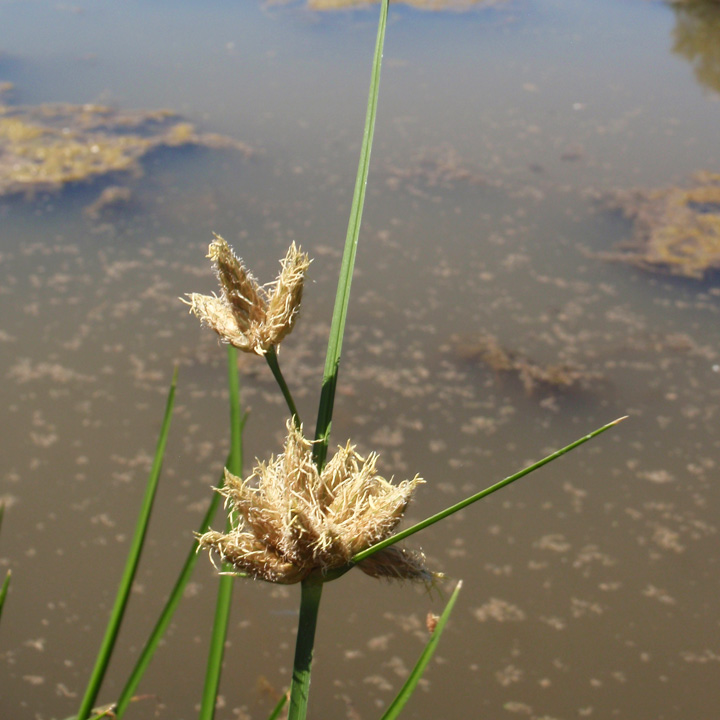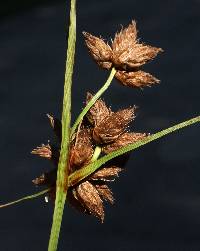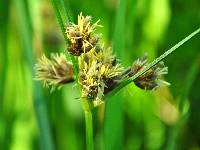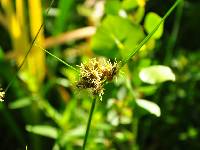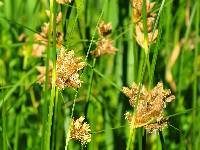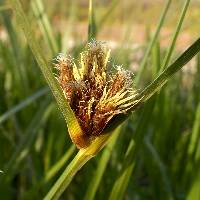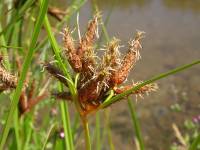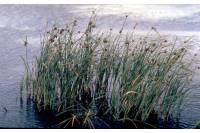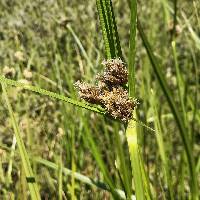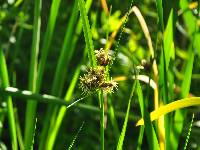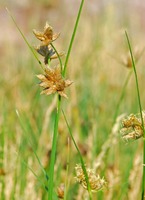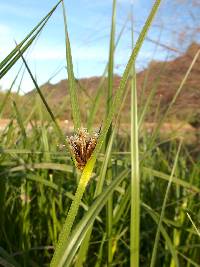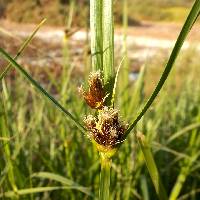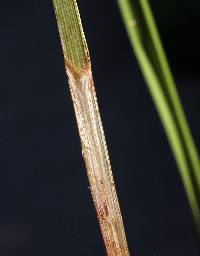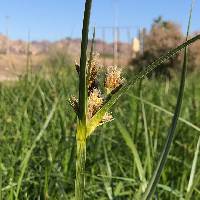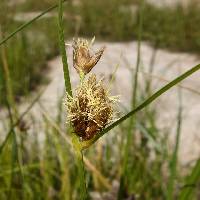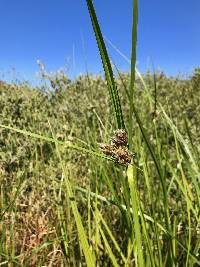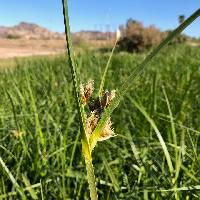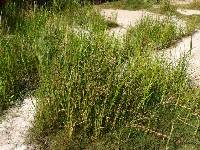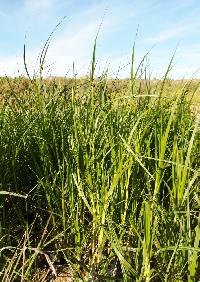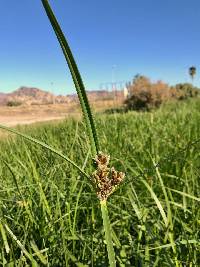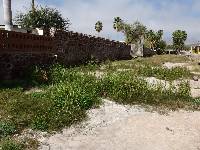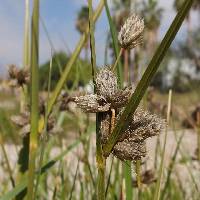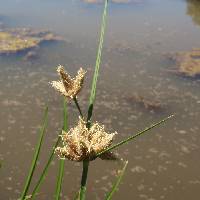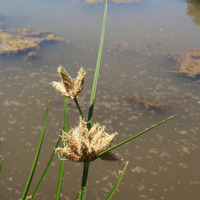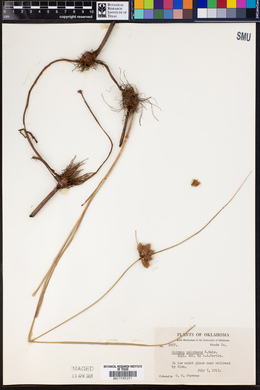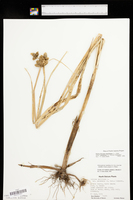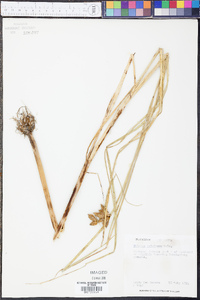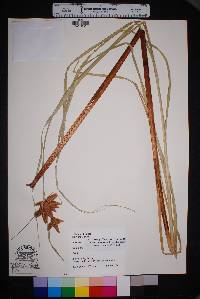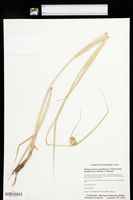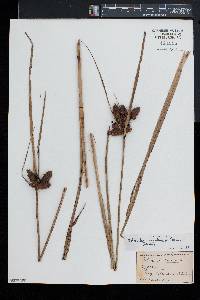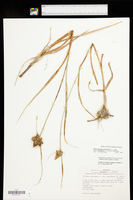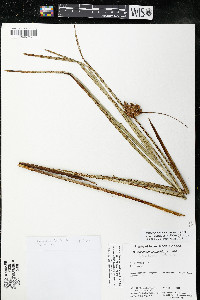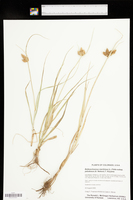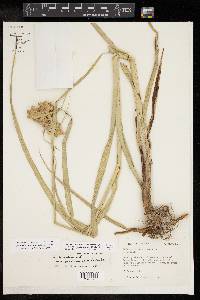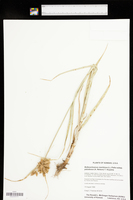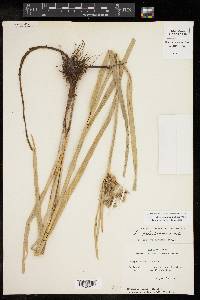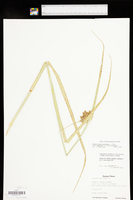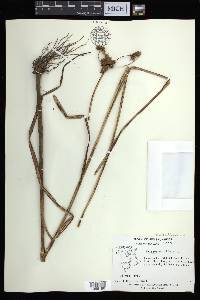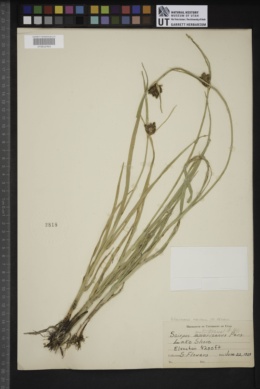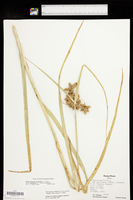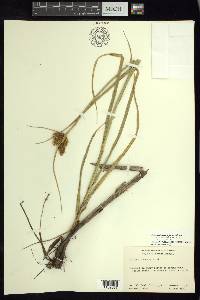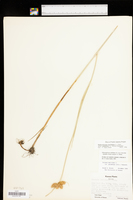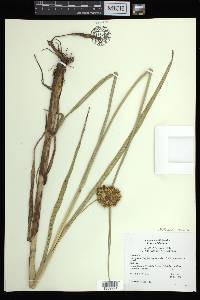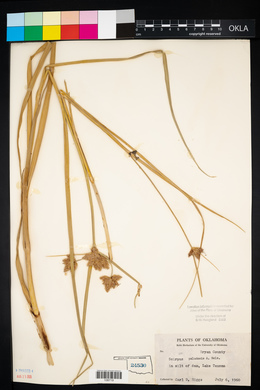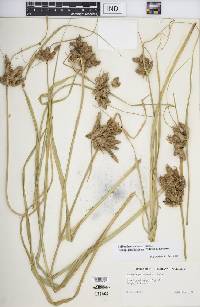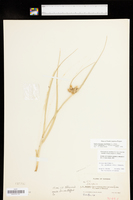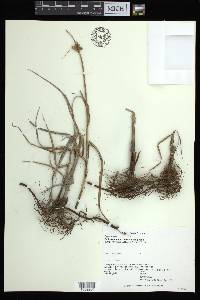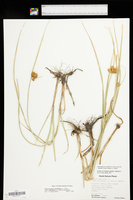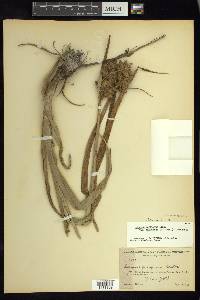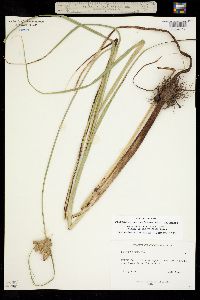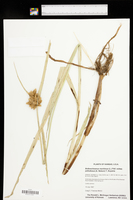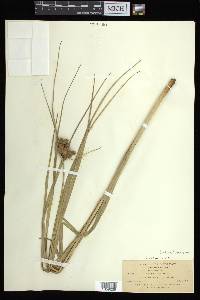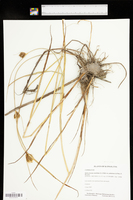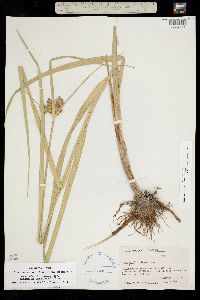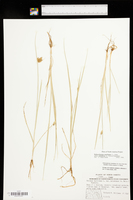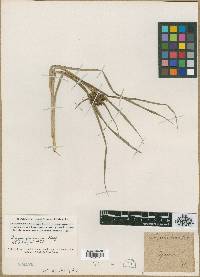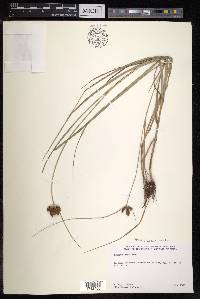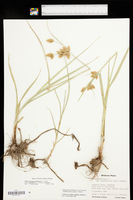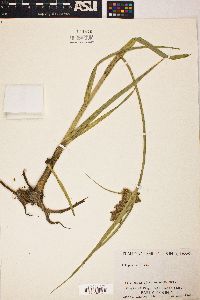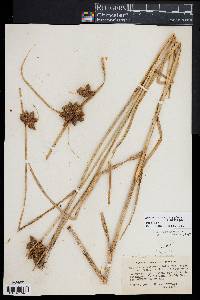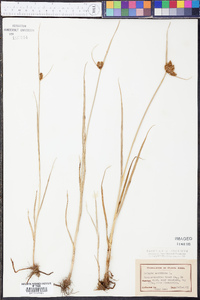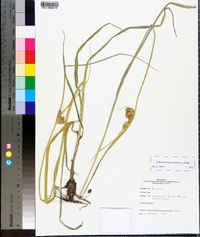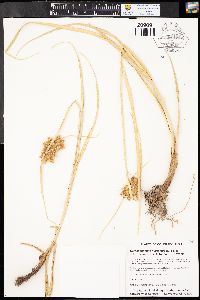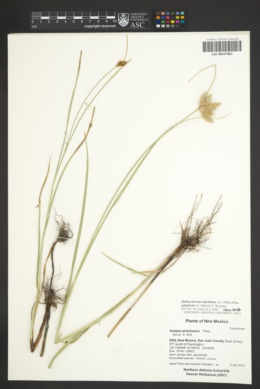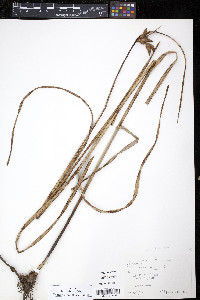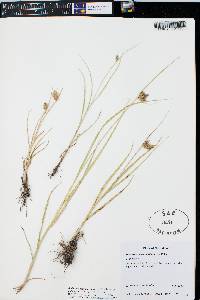Bolboschoenus maritimus
|
|
|
|
Family: Cyperaceae
Alkali Bulrush, more...cosmopolitan bulrush, Saltmarsh Wood Club-Rush, salt marsh bulrush, cosmopolitan bulrush (es: falso esparto)
[Schoenoplectus maritimus (L.) Lye, moreScirpus fernaldii Bickn., Scirpus macrostachys Willd., Scirpus maritimus L., Scirpus maritimus var. fernaldii (Bickn.) Beetle, Scirpus maritimus var. maritimus , Scirpus pacificus Britt.] |
Culms 50-150 cm × (1-)3-8 mm. Leaves: sheaths reaching ± to mid culm, fronts usually membranous at mouth, apex concave to convex, veins diverging proximal to summit leaving triangular, veinless area (often disintegrating); widest blade 2-12 mm wide. Inflorescences with all spikelets sessile, simply branched with not more than 1/2 of spikelets solitary or in clusters of 2-10 on 1-4 rays, rays not exceeding 8 cm; involucral bracts that surpass inflorescences 1-4, widest bract 1-6 mm wide. Spikelets (1-)2-40, ovoid to lanceoloid, 7-40 × (4-)7-10 mm, base usually cuneate to rounded; scales often loosely imbricate, bright orange-brown to stramineous, often obscurely lineolate-spotted, 5-8 × 3-4 mm, membranous, translucent, apex acute, 2-fid 0.5-1 mm deep, awn slender, 1-3 × 0.25 mm at base. Flowers: perianth bristles not persistent on shed achenes or sometimes 1-few weakly persistent, medium brown, to 1/2 achene length; anthers yellow, very rarely orange, 2-4 mm; styles 2-3-fid. Achenes medium to dark brown, rarely yellowish or whitish, obovoid, biconvex, or concave-sided, rarely obtusely compressed trigonous, 2.3-4.1 × 1.9-2.8 mm, apex rounded to nearly truncate, beak 0.1-0.4 mm, surface glossy, exocarp (epidermal) cells usually clearly visible at 10-20X; in achene cross section exocarp 2 times as thick as mesocarp, its cells greatly enlarged, at least 3 times deeper than wide; achene specific gravity much less than water. Bolboschoenus maritimus belongs to a difficult, worldwide complex, in which the delimitation of specific and infraspecific taxa is still unclear. The new lectotype and epitype from the Baltic coast of Sweden selected by S. G. Smith and I. Kukkonen (1999) are used here as the basis for redefining B. maritimus subsp. maritimus, which was previously defined to include B. yagara (Ohwi) Y. C. Yang & M. Zhan (J. Browning et al. 1996; Z. Hroudová et al. 1998). It seems likely that some populations of both Bolboschoenus maritimus subsp. maritimus and B. maritimus subsp. paludosus have been introduced into the flora from Eurasia. Putative Bolboschoenus maritimus × B. robustus hybrids are common in zones of sympatry along the northern Atlantic Coast and in California, putative B. fluviatilis × B. maritimus hybrids occur in California, and many B. glaucus × B. maritimus hybrids occur in California and Idaho (J. Browning et al. 1995). They are intermediate between their putative parents in every character studied and are often fertile. Interspecific hybridization is probably responsible for much of the infraspecific variation in B. maritimus, especially along the northern Atlantic and California coasts. The orange anthers and few 3-fid styles on some specimens from southeastern Texas may be due to introgression from B. robustus. The type of Scirpus maritimus forma agonus Fernald is probably a B. maritimus × B. robustus hybrid. Bolboschoenus maritimus and B. robustus have been widely confused in the southwest, where some authors (e.g., H. L. Mason 1957; P. A. Munz 1959, 1968) have treated B. maritimus as a synonym of B. robustus, and others (D. S. Correll and H. B. Correll 1972) have treated B. robustus as B. maritimus var. macrostachyus Michaux. No acceptably vouchered chromosome counts for Bolboschoenus maritimus are available from North America. The voucher for the 2n = 90 count by N. A. Harriman (1981) from southeastern Texas is a mixed collection of B. maritimus subsp. paludosus and B. robustus. Reasonably reliable chromosome numbers reported for B. maritimus in Europe are mostly 2n = 108 or 110, but vary from 2n = 55 to 112 (V. Jarolímová and Z. Hroudová 1998).
Perennial herb with tuber-bearing rhizomes 0.5 - 1.5 m tall Leaves: several, three-ranked, alternate, elongate, 2 - 12 mm wide, more or less flat, linear, parallel-veined, keeled beneath, with a sheathing base that encloses the stem (margins of the sheath fused together). Sheaths reaching more or less middle of culm, tubular with a concave or convex apex, veins diverging near apex (leaving a thin, veinless, triangular area), usually membranous at mouth. Inflorescence: composed of solitary and two- to ten-clustered spikelets, subtended by spirally arranged leaf-like bracts. Bracts (that surpass inflorescences) one to five, unequal, some elongate, to 6 mm wide. Rays (branches of inflorescence) one to four, to 8 cm long. Flowers: minute, subtended by a floral scale, lacking sepals and petals, with two to six bristles. Bristles weak, brown, to half the length of the achene, deciduous. Stamens three, exserted. Anthers yellow, 2 - 4 mm long. Pistil one. Style linear, two- or three-cleft. Fruit: a one-seeded achene, brown to nearly black, 2.5 - 4 mm long, 2 - 3 mm wide, reverse egg-shaped with a rounded or nearly truncate (cut straight across) apex bearing a tiny beak, biconvex or concave-sided or obscurely three-angled, glossy. Seed with a thin, non-adherent wall. Culm: stout, 0.5 - 1.5 m long, 3 - 8 mm wide, strongly three-sided, solid, cormose at the base. Spikelets: one to forty, most stalkless, 7 mm - 4 cm long, 7 - 10 mm wide, egg-shaped to lance-shaped with a tapering to rounded base and blunt or pointed apex, with more than 25 floral scales. Scales spirally arranged and loosely overlapping, brown to straw-colored or nearly colorless, obscurely streaked-spotted, 5 - 8 mm long, 3 - 4 mm wide, minutely hairy beneath, often becoming hairless, membranous, translucent, with a notched tip bearing a stiff, 1 - 3 mm long bristle (awn). Similar species: The similar Bolboschoenus fluviatilis differs by having 3.5 - 5.5 mm long, sharply three-angled achenes and flower bristles that are stout and persistent. See the two varieties for additional information. Flowering: late May to October Habitat and ecology: Some populations may have been introduced from Europe or be the result of introgression between Bolboschoenus robustus or B. novae-angliae. Roadside ditches and other wet areas where salt may accumulate. Occurence in the Chicago region: native Etymology: Bolboschoenus comes from the Greek words bolbos, meaning swelling or bulb, and schoenus, meaning rush, referring to the bulbous tubers which makes it different from the genus Schoenus. Maritimus means "of or from the sea." Author: The Morton Arboretum Stout perennial with tuber-bearing rhizomes; stems mostly 6-15 dm, sharply triquetrous; lvs usually several, elongate, ±flat, to ca 1 cm wide; orifice of the lf-sheaths truncate or concave, the ventral veins gradually diverging well below the summit and the intervening thin triangle easily torn; bracts 2-5, the outer elongate, the inner dilated at base and contracted to a narrow blade; spikelets 3-20+, some or all sessile in a central cluster, some often single or clustered on rays to 5 cm, ovate to cylindric, 10-40 mm; scales puberulent, thin-margined, notched at the tip, the midvein prolonged into a curved awn 1-3 mm; bristles 2-6, shorter than the achene, or obsolete; style bifid or trifid; achene brown to black, glossy, lenticular or planoconvex to trigonous, 2.5-4 mm, obovate, broadly rounded to the minute beak-apiculus; 2n=80-114. Fr June-Sept. (Bolboschoenus m.) Fresh, saline, or alkaline swamps and marshes; interruptedly circumboreal, with 2 vars. in our range. Atlantic coastal plants represent the var. maritimus, found also in Europe, bicarpellate or often tricarpellate, with ±acute spikelets and with the inner invol bracts often basally anthocyanic. Western plants, extending e. to Minn., Mich., and Mo., represent the dubious var. paludosus (A. Nelson) K From Flora of Indiana (1940) by Charles C. Deam Indiana Coefficient of Conservatism: C = null, non-native Wetland Indicator Status: OBL |
|
|
|

